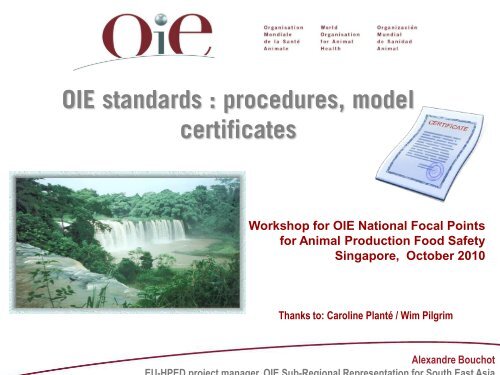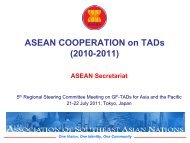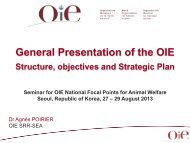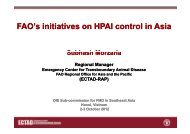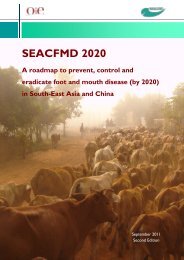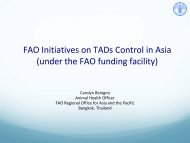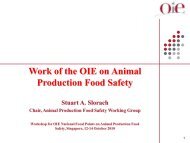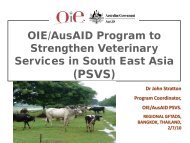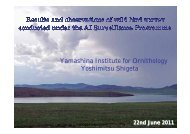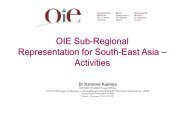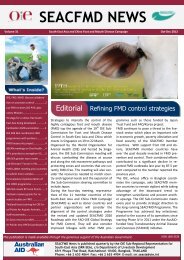certification certificates - OIE Asia-Pacific
certification certificates - OIE Asia-Pacific
certification certificates - OIE Asia-Pacific
- No tags were found...
Create successful ePaper yourself
Turn your PDF publications into a flip-book with our unique Google optimized e-Paper software.
<strong>OIE</strong> standards : procedures, model<strong>certificates</strong>Workshop for <strong>OIE</strong> National Focal Pointsfor Animal Production Food SafetySingapore, October 2010Thanks to: Caroline Planté / Wim PilgrimAlexandre Bouchot
CERTIFICATIONREF IN THE TERR. CODECertificateSpecific requirements on <strong>certification</strong>:‣ Section 5 – Trade measures, import/exportprocedures and veterinary <strong>certification</strong>Chapter 5.1 – General obligations related to <strong>certification</strong>Chapter 5.2 – Certification proceduresChapter 5.10, 5.11, 5.12 – Models of veterinary<strong>certificates</strong>/passport for horses
CERTIFICATIONGENERAL ASPECTSInternational veterinary health <strong>certificates</strong>:‣ Official document drawn up by exporting countryCertificate‣ Describe animal health requirements+ public health requirements (where appropriate)for the exported commodity‣ Quality of exporting country’s VS is crucial‣ Requirements take into account health status ofexporting and importing countries (+ transit if relevant)‣ Based on recommendations in the <strong>OIE</strong> Code + Codex(where appropriate)
CERTIFICATIONCONFIDENCECertificateCompliance with fundamental principles of qualityof VS important to establish and maintainconfidence in international veterinary<strong>certificates</strong> established by a Member‣ Section 3 – Quality of Veterinary ServicesChapter 3.1 – Veterinary ServicesChapter 3.2 – Evaluation of Veterinary Services
CERTIFICATIONRESPONSABILITYCertificateThe Head of the Veterinary ServicesIn general, CVO of the exporting country=> is ultimately accountable for veterinary<strong>certification</strong> used in international trade.
CERTIFICATIONCERTIFYING VETERINARIAN (1/2)CertificateVeterinary Authority responsible for‣Authorisation of certifying veterinarians‣Definition of functions, duties and conditionscovering suspension and termination‣Provision of relevant instructions and training‣Monitoring to verify their integrity andimpartiality.
CERTIFICATIONCERTIFYING VETERINARIAN (2/2)CertificateCertifying veterinarian must:‣Only certify matters within their knowledge‣Only sign where certificate completed fully andcorrectly‣Have no conflict of interest
CERTIFICATIONSANITARY REQUIREMENTS (1/2)Sanitary import requirements agreed betweenimporting and exporting countries’ VeterinaryAuthoritiesCertificate‣ Importing country should restrict requirements tothose necessary to achieve the national AppropriateLevel of Protection (ALOP)‣ Based on international standards (<strong>OIE</strong> + Codexwhere relevant)Or if stricter => based on an import risk analysis‣ Should not include requirements for the exclusion ofpathogens or animal diseases present in theimporting country and not subject to any officialcontrol programme
CERTIFICATIONSANITARY REQUIREMENTS (2/2)CertificateCertification requirements should :‣Be included in the model of <strong>certificates</strong>approved by <strong>OIE</strong>‣Be exact, concise, unambiguous and feasible‣Convey wishes of the importing country‣Be based on highest possibleethical standards (professionalintegrity of certifying vet to berespected and safeguarded)
CERTIFICATIONCERTIFICATES (2/2)CertificatePrinciples :‣text only amended by deletions which are signedand stamped by certifying vet.‣Signature and stamp of different color to that ofthe printing of the certificate‣Replacement requirements‣Originals only‣If electronic <strong>certification</strong>, need for securitysystems
CERTIFICATIONIMPORT CONTROLCertificate‣Meat and products of animal origin- for human consumption Art 5.7.3- for use in animal feeding, pharmaceutical, surgical,agricultural or industrial use Art 5.7.4=> Must be accompanied by an international veterinarycertificate conforming with <strong>OIE</strong> model‣Vet. Authority’s Inspection :- IVC not compliant or- possible danger to health of persons or animalsReturn orAdequate treatment to ensure safety
CERTIFICATIONMODEL CERTIFICATES<strong>OIE</strong> has collaborated with Codex in regard to thedevelopment of combined <strong>certificates</strong> for animalproducts.<strong>OIE</strong> ad hoc Group reviewed current guidance onveterinary <strong>certification</strong>, including updating model<strong>certificates</strong>• taking account of Codex and UN-CEFACT work in this areaand• ensuring compatibility with electronic <strong>certification</strong> systems● <strong>OIE</strong> models are baseline: content and form may bemodified as required13
CERTIFICATIONCERTIFICATESBased on <strong>OIE</strong> Code and Codex,indicate precisely :- Animal health requirementsand- Public health requirements14
CONCLUSIONCompliance with <strong>OIE</strong> standards of quality andevaluationEssential forEfficiency of VSTrust in VS’ <strong>certificates</strong>appropriate <strong>certification</strong>
World organisation for animal health12 rue de prony75017 Paris, FranceTel: 33 (0)1 44 15 18 88 – Fax: 33 (0)1 42 67 09 87Email: oie@oie.inthttp://www.oie.int


